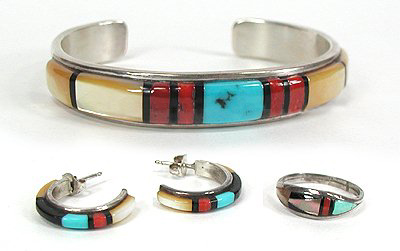This post relates to hallmarks but it also contains an important caution about internet searches. Read on.
Previously someone had written me about a Navajo artist, Simon Yazzie and several people wrote in comments that they also had heard of an artist called Simon Yazzie. You can read that complete thread here.
https://nativeamericanjewelrytips.wordpress.com/2010/07/30/native-american-hallmarks/
This past week I received this new query from a reader:
Hi Paula,
I run a jewelery store and recently bought two silver pendants from a walk in customer that have “SY Sterling” on the back. I know a lot about jewelery, EXCEPT for Native American jewelery. I would like to sell these items but do not want to falsely label or price what they are…can you please help?! I can email pictures to you if you like…thanks a bunch, J
The SY hallmark immediately made me think of the recent discussion about Simon Yazzie (see link to related post above) since several readers had suggested there was such an artist and there very well might be – I am just not familiar with his work or his hallmark.
We have had items by Steve Yellowhorse in our store and Steve usually uses the hallmark SY with a horse.
So before I answered J, I typed “Simon Yazzie” in google and on the first page of 10 results, there was a link to this blog in about 4th position connected to the above referenced article.
So I clicked on 4 of the other top search results and 3 opened with a Warning message from my browser and my anti-virus program that the sites were a potential threat. Immediately I closed those. The other one I opened started automatically running a fake (but seemingly real) Windows Security Scan – looked just like your Windows program screen might look and after a 5 second faux scan, it said that it had discovered 7 Trojans and viruses and so forth. And it asked me to click a certain button to fix the problems.

I did not click (a good rule of thumb is to never click anything you are not sure of to avoid virus contamination). I closed that window, closed my browser and then opened my Anti-Virus program (which happens to be Trend Micro) and did a scan of my hard drive which revealed NO THREATS.
Then, I reopened my browser and typed in some other artist’s names just to test but with them, I got typical, legitimate results.
I once again typed in “Simon Yazzie” and got the bogus results again that I described above.
So I wanted to pass this along to you all – for some reason, there is something odd going on with the Simon Yazzie name on the internet. And I want to caution you to avoid those websites that come up if you would happen to do a search.
Now to answer J’s question:
Dear J –
I hope this will be of help.
Please realize it is only my opinion based on the photos you sent.
My first impression and that of my husband is that the pendants are not Native American made. If we had received them in a pawn lot, we would put them in our Bargain Barn where we list items that we can not authenticate.

Some of the items we sell there might very well be Native American but we won’t list an item as such unless we are sure. It seems to me that the two pendants you have look more like Asian (or possibly Mexican) reproductions attempting to look like a Native American style piece. I could be totally wrong but that is our collective impression.
There are several design features that do not seem “right”:
The design element on the bail of the pendant with the eagle head doesn’t seem right – it would traditionally be stamped or plain, but not with that textured portion.
The eagle head itself is beautiful but it just isn’t usual – we’ve seen some carved Mexican items like this.
The silver globs dropped randomly alongside the eagle head aren’t traditional – I’ve not seen that.
 The bezels of all the stones on the multi-colored stone pendant are unlike any Native American ones we’ve seen.
The bezels of all the stones on the multi-colored stone pendant are unlike any Native American ones we’ve seen.
 There are several stones that I question – they could be man made and that is why I don’t recognize them.
There are several stones that I question – they could be man made and that is why I don’t recognize them.
With all that said, my philosophy is, if it is a beautiful piece, price it accordingly and just don’t say or suggest that it could be Native American.
Unless you know for sure that an item is Native American made (by purchasing
the item from the artist directly or having a certificate of authenticity signed by the artist and provided by the person who sold it to you) it would be illegal to represent it as such. Legally, you can’t say something is Native American simply referring to its style – it must be Native American made to use that term.
You can read more about the legality of authenticity here
http://www.horsekeeping.com/jewelry/Authenticity.htm
So besides, Steve Yellowhorse’s SY hallmark with a horse, the only other use I have seen of SY is Shirley Yazzie whose pieces are very simple and traditional.











































